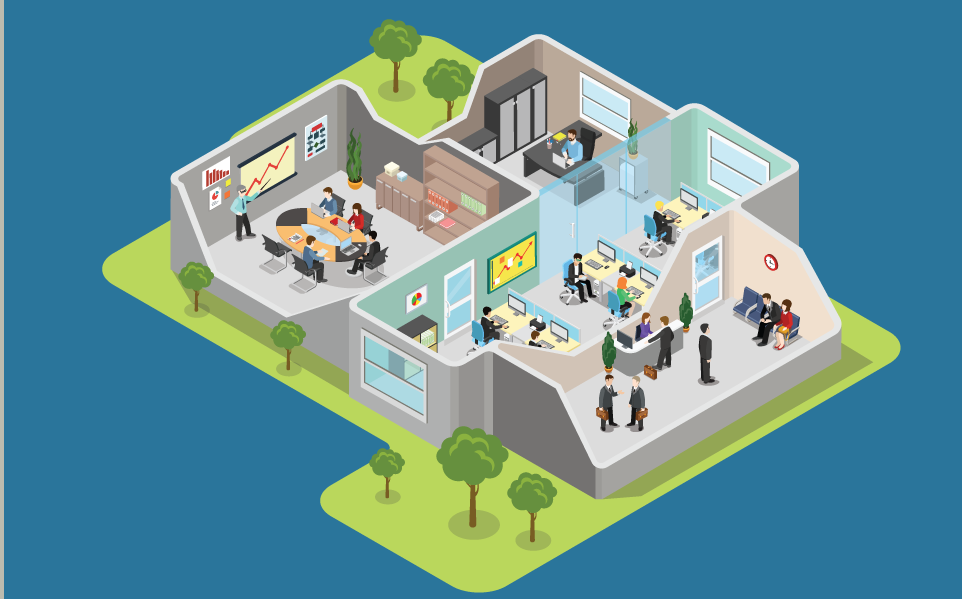07 Jul SABC 1 – Making Moves 3 Years Later
3 years ago I was feature on SABC 1 – Making Moves. You can access the initial episode by clicking here. This one here is a follow up episode 3 years later.
Video Transcript
Siya: This entrepreneurship is a journey, not a sprint. From the year 2008, Making Moves has showcased over 150 young entrepreneurs across all nine provinces. [Foreign language 00:00:18] On this season, we’ll revisit some of these businesses to find out what moves that they’ve been making since out last visit. It doesn’t matter how slow you go as long as you keep on moving.
Making Moves, inspiring a generation of young entrepreneurs.
Today, on Making Moves, we’ll revisit three entrepreneurs who first stepped onto our corridors in Season 5 and Season 3 respectively. Walter Tau of I-Youth Technology. Business was relatively new when we first profiled him and he had a long way to grow. Today, he is a father-to-be, but his business hasn’t progressed that much.
Walter: I welcome to our class [foreign language 00:00:59] not partition [foreign language 00:01:05]
Siya: Breeze Website Designers were profiled in Season 5. Against business challenges, financial problems, and business closure, today, he has managed to turn the clock in his business and has managed to grow his employees from 3 to 11.
Why, the last time I saw you, [inaudible 00:01:23]. The team has grown [inaudible 00:01:25] 10.
Muzikayise Nkosi from Ekasi IT Solutions is an entrepreneur at heart. In Season 3 of Making Moves, we first introduced you to this young entrepreneur hailing from Soweto. Since then, his business has moved from Soweto to Johannesburg CBD. With a satellite office in Pretoria and boasting a total of 22 employees, of which 16 are permanent employees.
[foreign language 00:01:50]
Muzikayise: I mean first impressions last, so a client will walk in, they have to be impressed. So then when you sit down for your meeting, they are already sold.
Siya: They are already sold.
The South African ICT sector performance review between 2009 and 2010 was 2.8% to the GDP.
Pule: It has been a major contributor in the economy in terms of the IT spend from government and as well as from the different companies that rely on the use of IT as technology.
Man 1: Five, 10 years ago, the industry was almost dead.
Man 2: In my opinion, there’s a lot of revenues for growth in the industry especially in Africa.
Siya: Direct contribution of the ICT sector to the GDP was 94.7 billion in 2012 measured at 2.9%.
Man 3: Well, I think there can be more done by young people.
Man 2: There’s quite a few example I can mention about African children from small villages coming up with apps or any technological innovations.
Woman 1: It’s different and it’s in fashion. And a lot of people need it right now.
Man 1: You still have big players who are playing this monopolistic sort of vibe, so which brings an opportunity for young, dynamic, and innovative companies to then join the market.
Siya: 26.8 billion worth of ICT products were exported, representing 2.8% of all exports in 2012.
Man 3: There are countries in the world which are very progressive regarding ICT. I think that we should actually look into that because it doesn’t require much capital, it doesn’t require much qualifications or licensing.
Man 1: I do think that we’ll see a lot more young people entering this space.
Man 3: I think many businesses would actually require people are able to develop softwares that protect against viruses, etc. So I think it’s very profitable. I think It’s fantastic for everyone who wants to have some sort of future or money. [Inaudible 00:04:22] like I said, you don’t really need much money to that. It’s a viable business, in my opinion.
Pule: The area of growth, really, is the area of services where you provide now other applications and things that are quite relevant to what the people need.
Siya: [Foreign language 00:04:49] Bongani. [foreign language 00:04:53] company as [foreign language 00:04:53] business. [foreign language 00:05:00] business [foreign language 00:05:01]. What is your [foreign language 00:05:04] 2016 [foreign language 00:05:12] 2016 [foreign language 00:05:23]
Bongani: My name is Bongani Gosa, born and raised in Mafikeng from Majemantsho. I came to Jo’burg 2001 to study IT. At the moment, [foreign language 00:05:43] BTech IT [foreign language 00:05:45] certificate in Advance Project Management. I’m running my own advertising agency [foreign language 00:05:51] North Riding.
Siya: [Foreign Language 00:05:52]
Bongani: All right.
Siya: Lead the way.
Bongani: Okay.
Siya: There years ago, last time [foreign language 00:06:03]
Bongani: Yeah, [foreign language 00:06:10] once in a while, maybe once every two or four weeks. [foreign language 00:06:17]
I think the strong quality that I’m good at, I’m a good organizer, yeah.
Man 4: He’s not one of those guys, about pretender, you know? Like we get to a place, the booze is too expensive, there’s no way he’s gonna sit there and spend $200 and pretend he enjoys it.
Bongani: I think my weak quality is mainly, to be honest with you, is [foreign language 00:06:44] no.
Siya: I know [foreign language 00:06:45]
Bongani: Yeah.
Siya: [foreign language 00:06:49]
Bongani: Yeah.
Siya: [foreign language 00:06:50]
Bongani: [foreign language 00:06:51] Yeah.
Siya: [foreign language 00:06:51]
Woman 1: Thank you.
Bongani: [foreign language 00:06:52] they just okay. I think [foreign language 00:06:58] their son is doing fairly well for himself in Gauteng, city of lights.
Siya: Yeah. [foreign language 00:07:05]
Bongani: [foreign language 00:07:07] nothing yet [foreign language 00:07:08].
Siya: [foreign language 00:07:10] headway.
Bongani: Yeah.
Siya: No, not small [foreign language 00:07:14]
Bongani: Yeah, yeah. So [foreign language 00:07:16] once again. [foreign language 00:07:18] I think, not I think, [foreign language 00:07:24]. It’s about time [foreign language 00:07:26].
Siya: How do you feel, Bongani, has grown [foreign language 00:07:35]?
Bongani: I think I have grown quite a lot as a person because since then, what I’ve also started doing, get up, public speaking, so just sharing knowledge about business and stuff like that, just to educate [foreign language 00:07:50] business, because this year’s my 10th year in pushing a business. It’s been very tough and very difficult.
Woman 2: [Foreign language 00:07:58] business [foreign language 00:08:00], you know, how to [foreign language 00:08:05]
Bongani: The website is just a small part of the advertising puzzle. So now what we do is that we try to solve a business problem through advertising.
Siya: [foreign language 00:08:26]. I’m happy so see that three years later, you’re still standing [foreign language 00:08:33].
Bongani: Yeah.
Siya: [foreign language 00:08:35] I want to see this growth. I’ve heard about it. Now [foreign language 00:08:39]
Bongani: All right. Let’s go.
Siya: Thank you.
Bongani: I’m founder and creative director at Breeze Website Designers, which is one of the few black advertising agencies our size. Our services are mainly vary from quite a number of things. We do animated explainer videos. We do websites. We do print. We do online advertising. We do all kinds of stuff. But our motto is very simple, “We grow when you grow.” Our business can only grow when we help our clients’ businesses grow. We can be found on www.bwdadvertising.co.za.
This is our new office. This is where we moved to.
Siya: Yes, sir. Bongani, before we go to way back and the move to that, [foreign language 00:09:51].
Bongani: That’s Chezille.
Woman 2: Hi Chezille.
Chezille: Hi, nice to meet you.
Bongani: She’s a graphic designer.
Woman 2: Okay. Interesting work.
Bongani: That’s Eddie.
Woman 2: Eddie, hi.
Bongani: Eddie’s a website designer, graphic designer as well.
Woman 2: Wonderful. So you guys are enjoying what you’re doing here.
Siya: Why, the last time I saw you, [foreign language 00:10:11]. The team has grown [foreign language 00:10:14] 10. How did the expansion come about? [foreign language 00:10:18]
Bongani: The expansion maybe came…had been like gradually, slowly, slowly, slowly, slowly. In essence, what we have done is that we started off with, like I said, it was only three of us, then we needed more capacity for more designers then we hired an extra designer. Then over time, we realized that, you know what, we need someone in-house that can do video animations, then we hired an animator.
Siya: [foreign language 00:10:44] three years ago.
Bongani: Yeah.
Siya: [foreign language 00:10:47] website and then [foreign language 00:10:51] advertising. [foreign language 00:10:56]
Bongani: A website is just a small part of the advertising puzzle. So now what we do is that we try to solve a business problem through advertising, in a sense, through storytelling. So that’s where this advertising part comes through. Because now you notice, we have kind of different people doing different things which all talk to kind of the same thing. So we’d have like a copywriter that writes out like stories about whatever needs to happen. We’d have like a graphic designer that can be the visual communicate, whatever you want to communicate. We’ve got animators that can make your pictures move and do fancy things. So we do quite a lot of stuff. So that’s why now, we’ve just evolved into an advertising agency, as opposed to just concentrating on a small part of advertising, which was websites. We still do websites.
Siya: Do you still remember some of the tasks that the judges and the mentor gave you on Making Moves?
Bongani: Yes.
Siya: The last time you were there.
Bongani: Yes, I do. One of them was to get a printed business profile.
Woman 2: You have an excellent team. I want you guys to put your head together, come up with something that’s wow. [foreign language 00:12:05]. I need you to come up with something that [foreign language 00:12:13]
Bongani: I’ve got a few there in my office.
Siya: Now you have [foreign language 00:12:16]
Bongani: Yes, we print like a thousand of them.
Siya: So that was the first time [foreign language 00:12:21]. The second one is do you remember that one?
Woman 2: He [foreign language 00:12:27] financial [foreign language 00:12:28]
Bongani: Yeah.
Woman 2: [foreign language 00:12:30] you know, [foreign language 00:12:31]
Bongani: The other one was not using the company’s [foreign language 00:12:46] I mean pizza.
Siya: [foreign language 00:12:50]
Bongani: No. What I’ve done now is I made sure that I get a salary so that I can use my personal card to buy whatever that I want as opposed to swiping [foreign language 00:13:01].
Lesedi: What I love most about it is the interaction with different people on a daily basis. You get to run into different sorts of people, people in different industries. You don’t come to work and meet the same people over and over again. So I quite enjoy that variation. He’s a cool boss. He’s reasonable, but obviously, within the bounds of what’s professional.
Siya: Pule Ganyane boasts of over 10 years’ experience in the IT industry. Over the years, he has built experience in various aspects ranging from account, project management to directorship. Pule Ganyane is a pioneer and a game changer in the IT industry.
Bongani: This is my office. Yeah, at least now, I’ve got a bit of privacy, so I can do quite a lot of things. And the nice thing is that I can also just look at the staff through this window. But at least I’ve got an office now, unlike three years ago, where we shared like space. Pretty much, there was no privacy to do anything.
Siya: [foreign language 00:14:13]
Bongani: Now the challenge [foreign language 00:14:18]. Our biggest challenge, it’s mainly sales and business development. At that time, we were targeting a particular type of client. But over time, now, we’re no more a just a website design company. We’re an advertising agency. So we’re taking a different type of client.
Pule: Getting more business is what we all want. If there’s a magic wand that one can do and get business, then you can do that. Getting sales people, getting feet on the streets and selling your product is a very key ingredient of business. Because if your produce things in your house but never get to sell them, you are like the light underneath the table.
Siya: [foreign language 00:15:10]
Bongani: Well, the growth plan is to become one of the biggest advertising agencies in South Africa. At the moment, we’ve got those big agencies around, but the bulk of them are foreign-owned. So over time, or within 10 years, our aim is to be the biggest advertising agency in SA.
Pule: Growth is an important part of a business, of any business for that matter. You don’t want to remain the same size. You want to be able to look back and say, “I was a this size 10 years ago, this is how we’ve incrementally grown.”
Bongani: And like I said, in the last episode, the issue was that we don’t have takeaway brochures. [inaudible 00:15:56] brochures.
Siya: This is what Tumi was talking about.
Bongani: Yeah.
Siya: Yes.
Bongani: And over and above that, we even take it further. Of course, we got featured on this publication which is Entrepreneurship. We also give this to clients because we bought 300 copies of this. So everyone that comes to our office or everyone that we interact with, we give them this and this as well.
Siya: [foreign language 00:16:16] 10,000 times.
Woman 3: Based on your pitch today, because this was what the investment was for, the judges were not convinced that they should give you the money, because you didn’t convince them properly in terms of how effective you’re going to use the money for. But all the best, you’ve got potential. Take all advise and make use of it and you will succeed.
Siya: [foreign language 00:16:46] Do you still share the same sentiments?
Bongani: Yes, I still share those exact same sentiments, because you’ll notice that I implemented all the advice that was given by the mentor at the time. Because at the time, like I said, she said, “You’re in the marketing, I mean, you do marketing but…”
Siya: No one knows about the business you market.
Bongani: Yeah, no one knows what I do.
Woman 2: [foreign language 00:17:15] you know, [foreign language 00:17:22]
Siya: [foreign language 00:17:25]
Bongani: I’d like to thank Making Moves for giving us the opportunity to showcase our growth, and most importantly, to show other entrepreneurs that if Bongani can do it, so can you.
Siya: 2013, the last time [foreign language 00:17:46]
Walter: Yeah, [foreign language 00:17:48]
Siya: No, [foreign language 00:17:53], I see a few changes. [foreign language 00:17:55]
Pule: It is important that a small company, so we should not do things just for the sake of doing them.
Siya: [foreign language 00:18:22] IT training center [foreign language 00:18:33] I last saw him three years ago and his business [foreign language 00:18:38]
Walter: I’m Walter Tau, born in Limpopo, qualified IT software developer, and owner of I-Youth Technology.
Siya: It’s been a long time since [foreign language 00:19:10] 2013.
Walter: 2013 [foreign language 00:19:13].
Siya: Speaking of which, [foreign language 00:19:15] congratulations are in order. [foreign language 00:19:17] Congrats.
Walter: Thank you. Yes, [foreign language 00:19:23]
Siya: So soon, [foreign language 00:19:35] will have a little bundle of joy.
Walter: June.
Siya: Will you be ready [foreign language 00:19:40]. Are you ready for fatherhood?
Walter: Yeah, ready [foreign language 00:19:47] because [foreign language 00:19:51] mistake, in terms of [foreign language 00:19:55].
Siya: If [foreign language 00:20:03] business [foreign language 00:20:05] what do you enjoy doing these days [foreign language 00:20:08]?
Walter: Yeah. [foreign language 00:20:09] sport. If I [foreign language 00:20:12] business, I like [foreign language 00:20:15] Sixteen Valve.
Siya: [foreign language 00:20:25] Sixteen Valve, maybe you [foreign language 00:20:27] Sixteen V so [foreign language 00:20:29].
Man 5: [foreign language 00:20:34]
Walter: [foreign language 00:20:37] It was a small team, so [foreign language 00:20:42]. I was one of the best player at that time because [foreign language 00:20:47] Doctor [foreign language 00:20:50]
Siya: [foreign language 00:20:52] the last time [foreign language 00:20:53]
Walter: Yeah, [foreign language 00:20:56].
Siya: No, [foreign language 00:21:00] a few changes. [foreign language 00:21:03]
Walter: Internet services, we help the university student with their assignments. We help them. We teach the end user computer, or the community. I’m the owner of I-Youth Technology. I-Youth Technology provide the following services. We provide website design. We provide telecommunication networks. And we also provide training. If you want more about our services, you can go to our website. Our website is www.iyouth.co.za. If you wanna visit our offices, you can find us at this address: 2555 Teresa Street, Mayibuye.
Siya: [foreign language 00:21:49] Take me through.
Walter: Reception [foreign language 00:22:00] privacy class so [foreign language 00:22:03] privacy [foreign language 00:22:06] office [foreign language 00:22:07] internet café [foreign language 00:22:09]
Siya: Nice.
Walter: You’re welcome.
Siya: So the changes that you’ve done [foreign language 00:22:19] business [foreign language 00:22:19], you wanna impact your business in what way? And how will they help the business to grow?
Walter: [foreign language 00:22:24] one of our lady [foreign language 00:22:27] filing [foreign language 00:22:27] filing and PA, sort of. And then [foreign language 00:22:36] assist, facilitate my student. Some of the changes [foreign language 00:22:43] internet café is [foreign language 00:22:52] class [foreign language 00:22:55] core business [foreign language 00:22:56] website [foreign language 00:23:00] two clients so far. And then telecommunications [foreign language 00:23:06] provide the landlines and we store the networks.
Welcome to our class [foreign language 00:23:13] 2013, there is no partition. [foreign language 00:23:18] desk [foreign language 00:23:20] control the student [foreign language 00:23:24]. So that’s why I decided to put a partition, so that there is privacy for the student.
Lethabo: [foreign language 00:23:30] Excel, PowerPoint. [foreign language 00:23:37] apply [foreign language 00:23:42] assignment [foreign language 00:23:46]
Siya: So how do I [foreign language 00:23:49] First thing, [foreign language 00:23:54] partitioned, [foreign language 00:23:56] privacy, but the space is limited.
Woman 2: Here, so this is where you are.
Walter: This is a center.
Woman 2: Right.
Walter: [foreign language 00:24:03] those are computers for the school and then [foreign language 00:24:03] the office.
Woman 2: Okay, very quaint.
Walter: Our office at the same time, it’s everything. All in one.
Woman 2: Right, right, okay.
Siya: So how many students do you see in a day.
Walter: Okay, [foreign language 00:24:19], every three months, my students is 15. Every time a student actually still [foreign language 00:24:26] classes are two a day. Another class [foreign language 00:24:32] student [foreign language 00:24:35] around 12 [foreign language 00:24:41], around five. So [foreign language 00:24:50] three [foreign language 00:24:52] seven, seven, another day, another five or six.
Siya: So what exactly [foreign language 00:24:59] do because now it’s [foreign language 00:25:00]
Walter: [foreign language 00:25:01] manager [foreign language 00:25:01] every day management.
[foreign language 00:25:09] processing [foreign language 00:25:11].
Woman 2: What’s taking long?
Walter: They need some documents, because it’s an application by area [foreign language 00:25:17].
Woman 2: [foreign language 00:25:18] corporation?
Walter: It’s a company, it’s a private company.
Woman 2: Pty?
Walter: Pty Ltd.
Woman: He’s all over the place when it comes to planning and prioritizing. When you open the business, you cannot operate if your documents are not already in order.
Pule: You must understand that the fundamentals of marketing talk about the 4 Ps of marketing. And you’re talking about price, you’re talking about the place, you’re talking about promotion, and they’re talking about the product.
Walter: The only problem [foreign language 00:25:47]
Siya: So Walter, I know accreditation [foreign language 00:26:14]
Walter: Yes.
Siya: So now what happens after the students [foreign language 00:26:17]?
Walter: So [foreign language 00:26:23] partnership with Siyafunda. Partnership with Siyafunda train the student, after we train the student, [foreign language 00:26:32] Siyafunda. Siyafunda [foreign language 00:26:41] issue the certificate, and [foreign language 00:26:48] graduations.
Aamed: Walter really engaged with us a few years back. In terms of our relationship with partners, the important thing is credibility, integrity, trust. That’s how relationships are built, and we’ve seen those qualities in Walter. He also had passion about community development, which we quite…is one of our key values that we look in terms of our partners and Walter had those qualities as well. Hence, we agreed that we’ll have a partnership with him.
Siya: [foreign language 00:27:19] R900 [foreign language 00:27:26]. Is it enough to make sure [foreign language 00:27:31] you have enough to cover the costs?
Walter: Yeah, enough to cover the costs. The only problem [foreign language 00:27:40] sustain a business [foreign language 00:27:49].
Pule: While it’s a good thing that people are paying for the training courses that you’re offering, because that shows appreciation that people are willing to pay for what they receive, you must understand that the fundamentals of marketing talk about the 4 Ps of marketing. And you’re talking about price, you’re talking about the place, you’re talking about promotion, and they’re talking about the product. In this case, the product is training, the price is R900. The people appreciate and pay for that price. And they see that there is value in paying for that price.
If you take it higher and there is a dwindle in the people that are coming, it could be that it is out of their price range at the moment. It may be that you need to have a strategy of looking at your price and your competitiveness and the offering of what you’re putting in front of the people. All of that has to be taken in a balance. You’ve got to say, “In this environment, what can I charge?” And it’s based on what you could do marker research on and find out if there’s a need and appreciation to pay that amount.
Siya: [foreign language 00:29:05]. So Walter, last time [foreign language 00:29:12] was 2013. It’s been three years since [foreign language 00:29:15]. It’s a long time in business, [foreign language 00:29:17]. But it feels like [foreign language 00:29:22] from where we were the last time [foreign language 00:29:24].
Walter: No, [foreign language 00:29:26]. As I said, maybe [foreign language 00:29:31] same place. [foreign language 00:29:35] experience [foreign language 00:29:38] today [foreign language 00:29:38] business. The income [foreign language 00:29:42].
Pule: While I do understand the pressure that Walter might be having in terms of space, it is important that as small companies, we should not do things just for the sake of doing them. One is to be mindful of how it’s going to impact on the other resources that you have, like your financial resources. If you move, for instance, from an area where you can comfortably have a production line on a low rental and things like that, you gotta consider that. You got to maintain that. I started my company in my house. For more than a year, we were in a little room in my house. There was three of us. I mean, the place was so small you had to go outside to change your mind.
But the point is that when the time is right, you got to move. And sometimes, it’s better to go into a place where there’s similar or complimentary business like yours. And when you do that, you’ll be able to go into an area where you can share resources. We did that. We moved into an area which we call a township in Midrand where we shared resources. There was about 10 companies, and we had 1 boardroom. But all those resources were shared equally among the companies. And we realized that in so doing, we could save so much more, and we could stretch the rand, as it were, a bit much farther. So I think those are things that you need to consider before you can move.
Siya: What would you say right now are your real challenges [foreign language 00:31:22]? What are some of those real, real challenges that you need help with, [foreign language 00:31:29] your business and take it further?
Walter: Our real challenge is [foreign language 00:31:33] space [foreign language 00:31:35] office container [foreign language 00:31:40] building. [foreign language 00:31:42] challenge, the real challenge so far.
Siya: [foreign language 00:31:47] business. One thing I’m impressed about is [foreign language 00:31:50] standing [foreign language 00:31:52]. You’ve made a few changes [foreign language 00:31:55]. Hopefully next time I [foreign language 00:31:58], you’ll be in a bigger space. [foreign language 00:32:01]
Walter: That’s our plans, for sure.
Siya: [foreign language 00:32:05]
Walter: [foreign language 00:32:08]
Siya: [foreign language 00:32:11] I hope will become more [foreign language 00:32:13]
Walter: [foreign language 00:32:14]
Siya: Thank you very much for your time [foreign language 00:32:17]
Walter: Thank you very much. Okay.
This program here profiled [foreign language 00:32:25] and [foreign language 00:32:29] because of this program, and hopefully, after this one, I believe that we’ll get our own space and accreditation and then run a professional business. Thank you, guys. Thank you very much.
Siya: This is [foreign language 00:32:51] since the last time he was here on the show. [foreign language 00:32:56] Ekasi IT Solutions. [foreign language 00:33:00] Dube. Things have changed. His business has improved [foreign language 00:33:04] in Johannesburg CBD and [foreign language 00:33:07] brance at Pretoria. [foreign language 00:33:09] improvements [foreign language 00:33:12] since the last time we saw him.
Muzikayise: [foreign language 00:33:20] Muzikayise Nkosi, the founder and CEO of Ekasi IT Solutions.
Siya: I last time [foreign language 00:33:29] 2009.
Muzikayise: Yeah.
Siya: [foreign language 00:33:32]
Muzikayise: [foreign language 00:33:34] yeah, [foreign language 00:33:35].
Siya: [foreign language 00:33:39]
Muzikayise: Yeah.
Siya: [foreign language 00:33:40] how old [foreign language 00:33:42]
Muzikayise: [foreign language 00:33:43] is 13 years and then [foreign language 00:33:45] is 7 years.
Siya: Seven years.
Muzikayise: Yeah. [foreign language 00:33:48]
Siya: Yeah. No, no, no, you [foreign language 00:33:52]
Muzikayise: Well, at this moment, I’m just fixed with this company because we [foreign language 00:34:12] building up. And [foreign language 00:34:13] We are about to open another branch.
Siya: [foreign language 00:34:17]
Muzikayise: [foreign language 00:34:17], yes. That one will be in Bryanston. We finalized everything. [foreign language 00:34:22] So because of that business, I don’t really get time to [foreign language 00:34:28] the only time [foreign language 00:34:29] family for a holiday. That’s the only I really got time. But therefore [foreign language 00:34:34], no. That one is just [foreign language 00:34:38] for now.
Siya: Last time [foreign language 00:34:40]
Muzikayise: [foreign language 00:34:44] before, he’s still my driving force.
Siya: [foreign language 00:34:52]
Man 6: [foreign language 00:34:58]
Siya: [foreign language 00:35:17]
Muzikayise: [foreign language 00:35:18]
Siya: [foreign language 00:35:20]
Muzikayise: I mean first impressions last. So the client mother will walk in, they have to be impressed. So then when you sit down for your meeting, they are already sold.
Emily: The only thing [foreign language 00:35:29] difficult because I need to report and report [foreign language 00:35:36], but every time [foreign language 00:35:38].
Muzikayise: I am the founder and CEO of Ekasi IT Solutions which specializes in three areas of business in ICT. Software development which we do school learner management system like this one, which is based on E-Learning systems in South Africa. We also develop mobile applications. And we also do learnerships based on the accreditation with MICT SETA, with ICB, and also Microsoft. We also do ICT support for businesses — small, medium, and also government. We are based in two offices, in Pretoria, Arcadia, and also based in Johannesburg central in Marshalltown. We can be found on www.ekasiit.com
Welcome to Ekasi IT Solutions.
Siya: Wow, impressive. No, no, no, no, no. I’m impressed. [foreign language 00:36:50]
Muzikayise: No [foreign language 00:36:51]
Siya: [foreign language 00:36:52]
Muzikayise: I mean first impressions last. When a client mother will walk in, they have to be impressed. So then when you sit down for your meeting, they are already sold.
Siya: They are already sold.
Muzikayise: That’s the whole plan.
Siya: [foreign language 00:37:02] Take me around. Take me around this building. [foreign language ]
Muzikayise: This is [foreign language 00:37:08].
Siya: [foreign language 00:37:10]
Edmond: Not so long, I started to work for Ekasi in 2014. But you’d be surprised that when I joined Ekasi, I was only an assessor. Then I rose through the ranks from an assessor to a training manager, training director, now, managing director. One thing I think from him is that he does reward performing employees. And not only performing employees, but I’ve come to realize that he makes sure that right people are in the right position in terms of qualifications, experience, and all that. And I think that could be the reason why I rose so quickly in a short field of time.
Siya: [foreign language 00:37:54] basic computer [foreign language 00:38:02]
Muzikayise: Yeah, [foreign language 00:38:16] we had to change our business strategy. So we wanted to align ourselves with the e-training environment of South Africa. So we had to register that this is a training provider. Even though we were registered at the time, [foreign language 00:38:30] extension of scope. Now no longer we were doing end user computing which is basic computing. But now we are also accredited to do technical support. We’re accredited to do system support, systems development, and we are accredited by MICT SETA, which is a body that regulates trainings which is a must-skills development in South Africa. That is one part of the business. But we are also a software developing company. We’ve hired top-end gurus in terms of software development. We’ve developed amazing softwares up to date. There’s a software that we are trying to introduce for the E-Learning, as you know, government wants to go paperless, so we have a software for that, but we are trying to push it is and see what the government can actually buy into.
Emily: [foreign language 00:39:16] find it difficult [foreign language 00:39:18] because of mainly I enjoy because of everything we do together. We travel together. Every time, we’re together, lunch together, so it wasn’t that difficult. Even now, we still do the same things, it’s not that difficult. But the only thing [foreign language 00:39:34] difficult because I need to report and report [foreign language 00:39:41] but every time [foreign language 00:39:43] pay a revenge.
Siya: [foreign language 00:39:48]. You know, I certainly looked at this thing, the language. To me, it doesn’t sound as if [foreign language 00:40:05] if you are a black person, [foreign language 00:40:06]. But we have to have those skills, so that otherwise [foreign language 00:40:10] those business skills. So basically [foreign language 00:40:13] Once [foreign language 00:40:18] a certain client, that client always refer us to other people, of which I think that’s the biggest marketing tool that you can ever have – word of mouth marketing or referrals. You can put out your grow channels and flyers television, but the biggest marketing tools, for other person to tell somebody personally that that company does a good job.
Vivette: The atmosphere in this place, it’s a little bit different than all the other campus, because you know, when I started, I thought it would hard because normal campus [inaudible 00:40:54] exams and it’s tense and you only get one chance. And you know facilitators don’t really teach you as they’re supposed to teach you. But it’s here, it’s different, you understand. They make sure that you pass. And it’s very…you feel at home.
Siya: I [foreign language 00:41:11]
Muzikayise: Yeah. [foreign language 00:41:23] class, because [foreign language 00:41:29] and as they come [foreign language 00:41:33] requirements are different.
Siya: Yes, sir. [foreign language 00:41:34] in total?
Muzikayise: In total, in Johannesburg, it’s like five classes.
Siya: Five classes.
Muzikayise: Yeah.
Siya: [foreign language 00:41:39]
Muzikayise: [foreign language 00:41:40] building, taken the whole 14th floor of the building [foreign language 00:41:44] and yeah, we’re covered in space.
Siya: [foreign language 00:41:47] from humble beginnings to [foreign language 00:41:47]
Muzikayise: Humble beginnings.
Siya: [foreign language 00:41:51]
Muzikayise: Okay.
Siya: [foreign language 00:42:02] challenges [foreign language 00:42:03]
Muzikayise: There’s a couple [foreign language 00:42:08] but the ones that stand alone [foreign language 00:42:10] late payments. You know, as a small business, because [foreign language 00:42:14] a liquid cash flow, it becomes difficult to keep afloat if clients are not paying us on time, not only government, but also on corporate. So our appeal to more businesses, [inaudible 00:42:25] they must pay us on time so that we can keep afloat and run and sustain ourselves.
Pule: Yeah, that’s a big problem. I think it’s one of the biggest contributors to eroding a lot of the SMME market. Most of the companies have gone down as a result of that, the late payment, especially from government. It is important that people should be able to pay for your services and pay, because you’ve got creditors as well that you need to pay. With the lack of cashflow, your company can go down. I wish I could give you sound advice on this, but this is what we all battle about. There’s structures that has been set-up where you can report such things in provincial and in local governments and in national government.
Siya: Ekasi IT, Ekasi IT, it catered for [foreign language 00:43:19]. Are we talking private sector, government, [foreign language 00:43:24] or students?
Muzikayise: Well, we cater for two major clients, in fact, [foreign language 00:43:30] industries. We cater for government, and we also cater for corporate. Now, [foreign language 00:43:36] they come in a partnership between the government, private sector, and us as training providers. That’s how learners come in, because we don’t do I’m a walk-in individual clients. We only deal with groups when it comes to corporate. When it comes to government, we then deal then with learnerships.
Siya: [foreign language 00:43:52]
Muzikayise: I was literally happy because we got recognition through Making Moves the first time, when we were featured. Because now, people will now recognize the company, the company name. They will recognize the face, which makes it easier when doing marketing. This will actually make it easier for us to actually go a step forward more than the way we had today.
Siya: [foreign language 00:44:16]
Muzikayise: Yeah, now we have a total of 20 people that are permanently employed with our company. [foreign language 00:44:28] Johannesburg, people who are residing there are 11, and then in Pretoria, it’s 9.
Siya: In Pretoria 9, Johannesburg 11.
Muzikayise: We obviously looking for growth [foreign language 00:44:36] Bryanston, we will need more people. [foreign language 00:44:39]
Siya: [foreign language 00:44:40] Bryanston [foreign language 00:44:43]
Pule: Expansion, by itself, is a good idea. But you don’t want to grow too fast and stretch your resources, and not be able to effectively utilize the resources that you have on hand. If you go out of the country, you got to make sure that you have actually consolidated before you leave the shores of South Africa. I think rushing ahead before you are ready can be a problem.
Muzikayise: Through the software development department, we’ve been travelling almost throughout Africa trying to build relationships with African states. That’s where we see ourselves now. We want to break the borders and not only operate in South Africa. But obviously, we’re also looking at having offices all around the provinces in South Africa. But our biggest wish, especially in [foreign language 00:45:37] as the head office is to have our own building.
Siya: I’m impressed about what I see. [foreign language 00:45:41] occupy [foreign language 00:45:45]. It’s so impressive [foreign language 00:45:50]
Pule: I think Ekasi IT is going places, because the company has the right mind frame, they are looking at expansion, they are thinking well beyond the shores of South Africa. They are thinking about the JSE and listing. They have E-Learning solutions which are well-sounded and which they want to implement. I think that they are on sound footing at it is at the moment. And I think that with just a little bit of hard work, we can see this company in a few more years coming through very well. There’s not much more advice one can give, but all the blessings to them, because they are in the right track, and they are moving in the right direction.
Siya: [foreign language 00:46:33]
Muzikayise: Yeah.
Siya: [foreign language 00:46:34]
Muzikayise: [foreign language 00:46:37] anywhere [foreign language 00:46:38], but they’ve decided [foreign language 00:46:40].
Siya: [foreign language 00:46:43]
Muzikayise: [foreign language 00:46:48] office [foreign language 00:46:49].
Siya: [foreign language 00:46:50]
Muzikayise: Yeah. But [foreign language 00:46:51]
Siya: [foreign language 00:46:55]
Muzikayise: So yeah, this is where I sit.
Siya: [foreign language 00:46:57]. From jeans and shirts [foreign language 00:47:03]. We haven’t done too bad. No, we haven’t done too bad.
Muzikayise: [foreign language 00:47:08].
Siya: Thank you for your time.




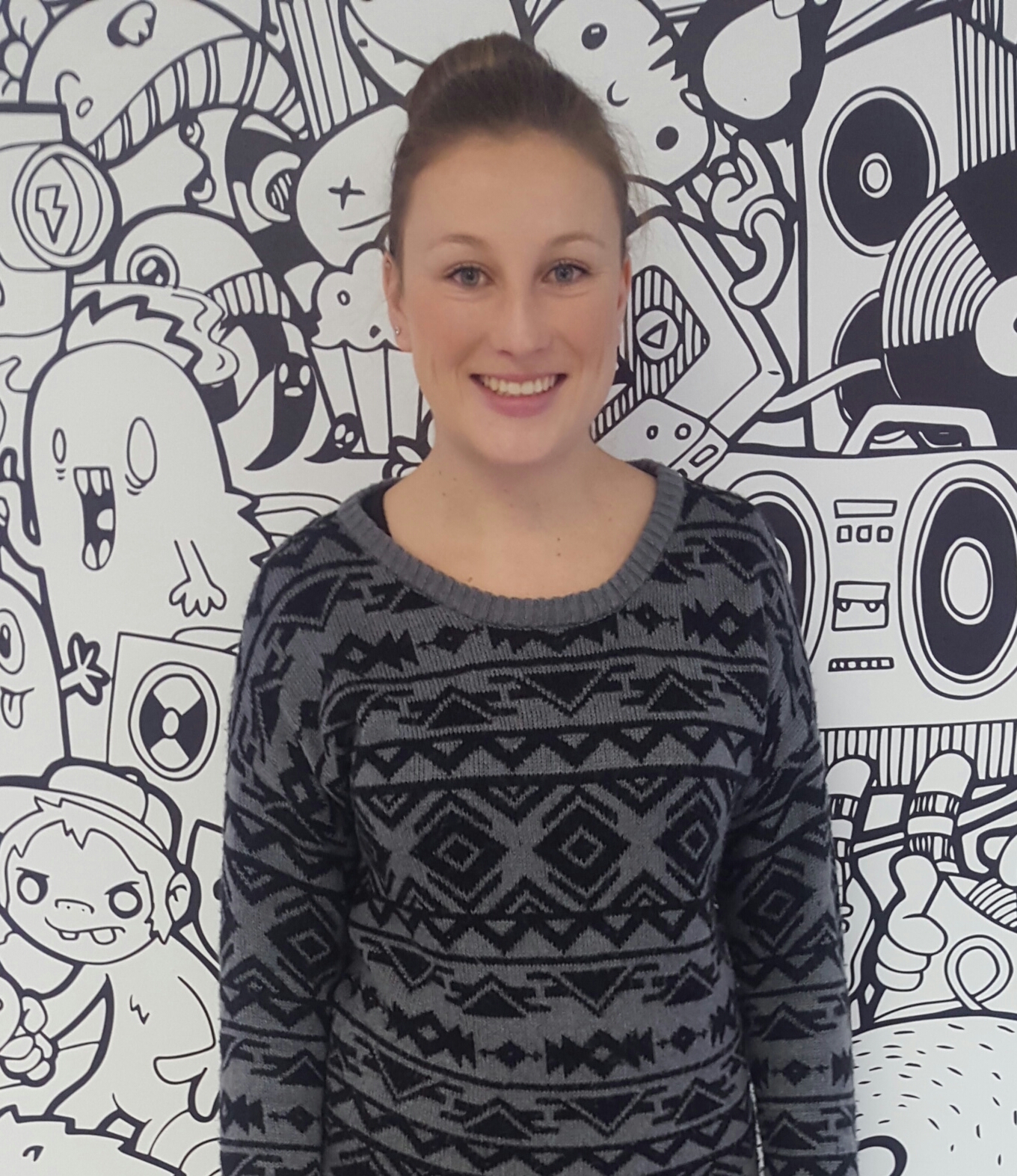
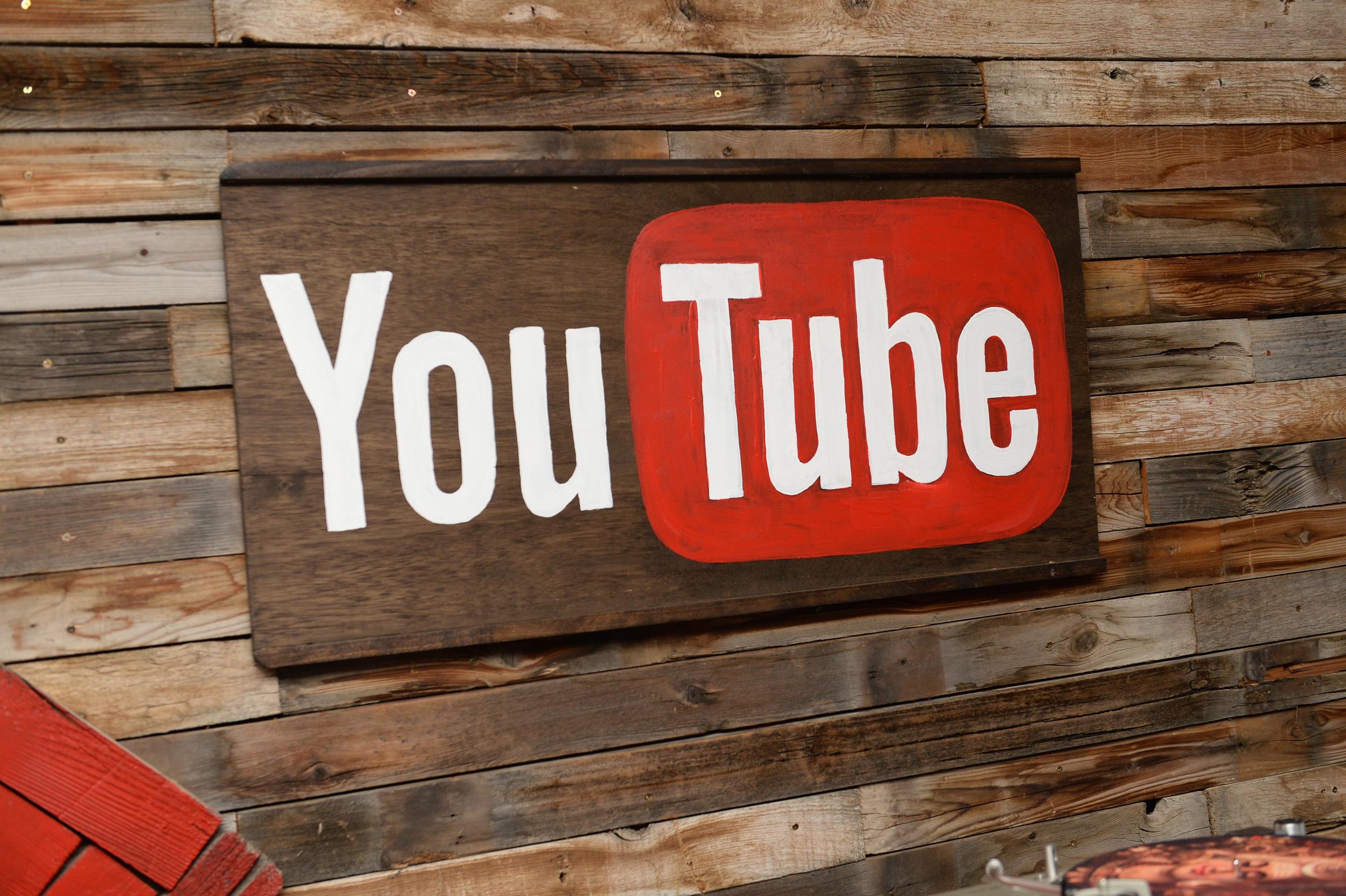


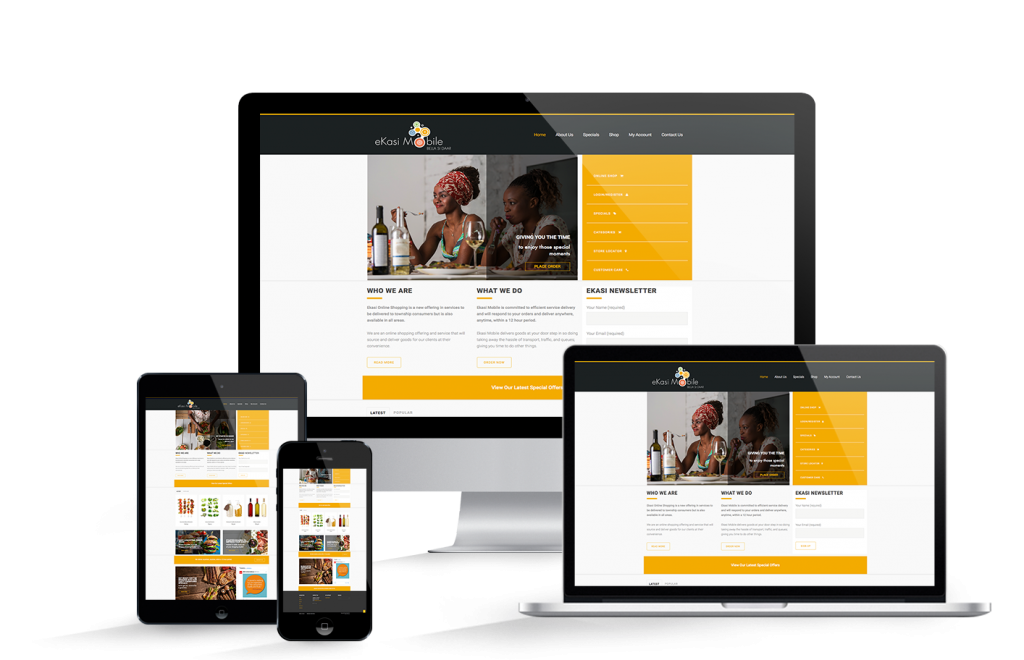



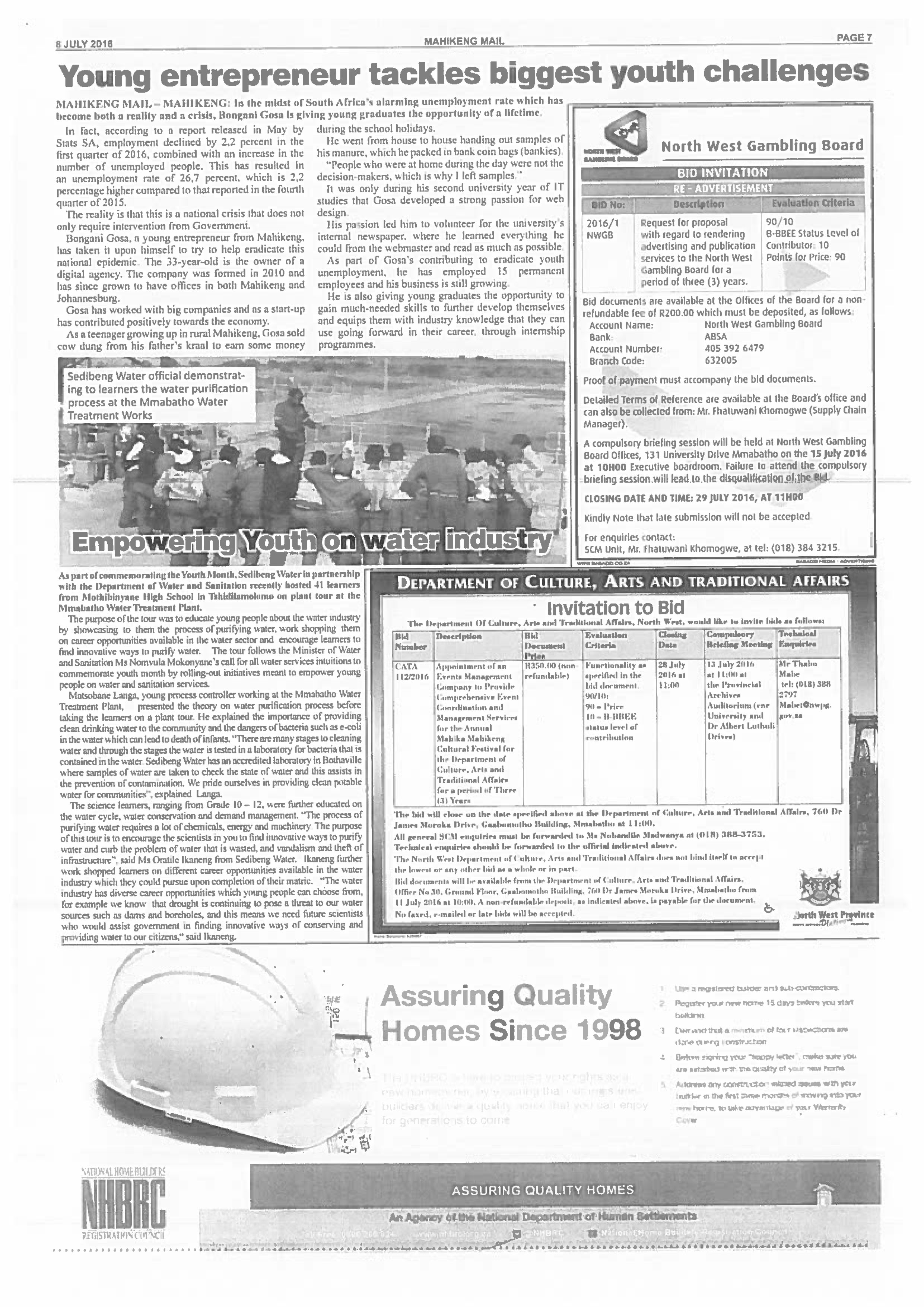 Read The Mahikeng_Mail Artice
Read The Mahikeng_Mail Artice

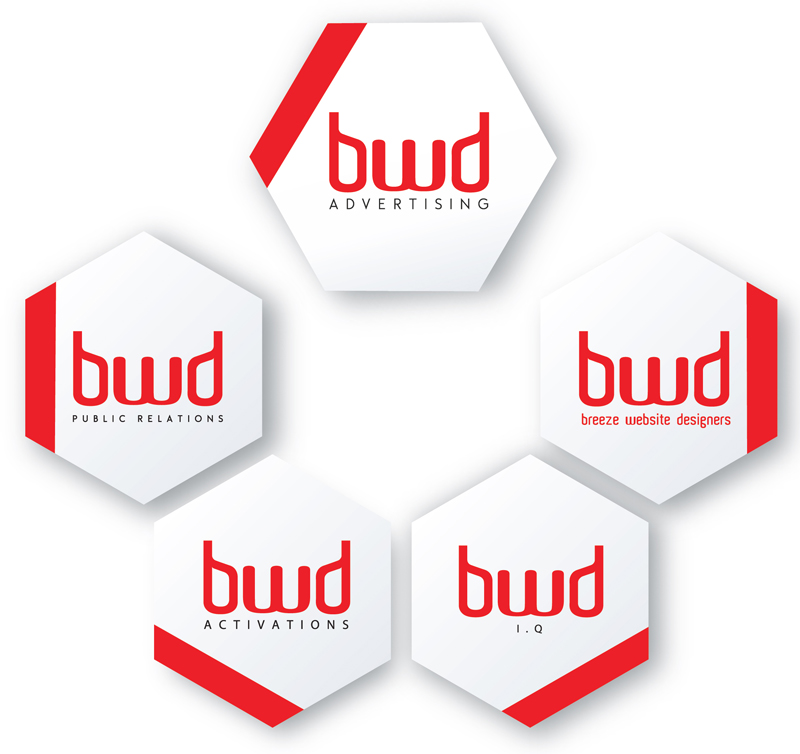
 If you are reading this, the above headline obviously worked.
If you are reading this, the above headline obviously worked.


